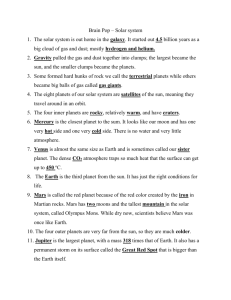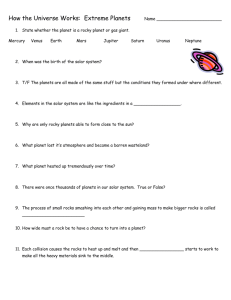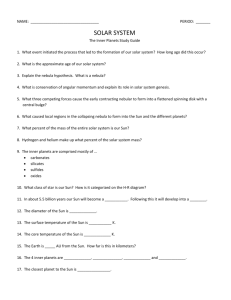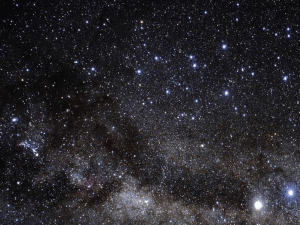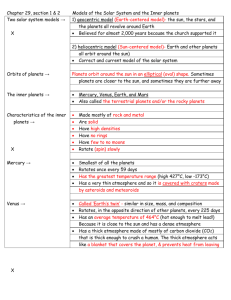Members of the Solar System
advertisement
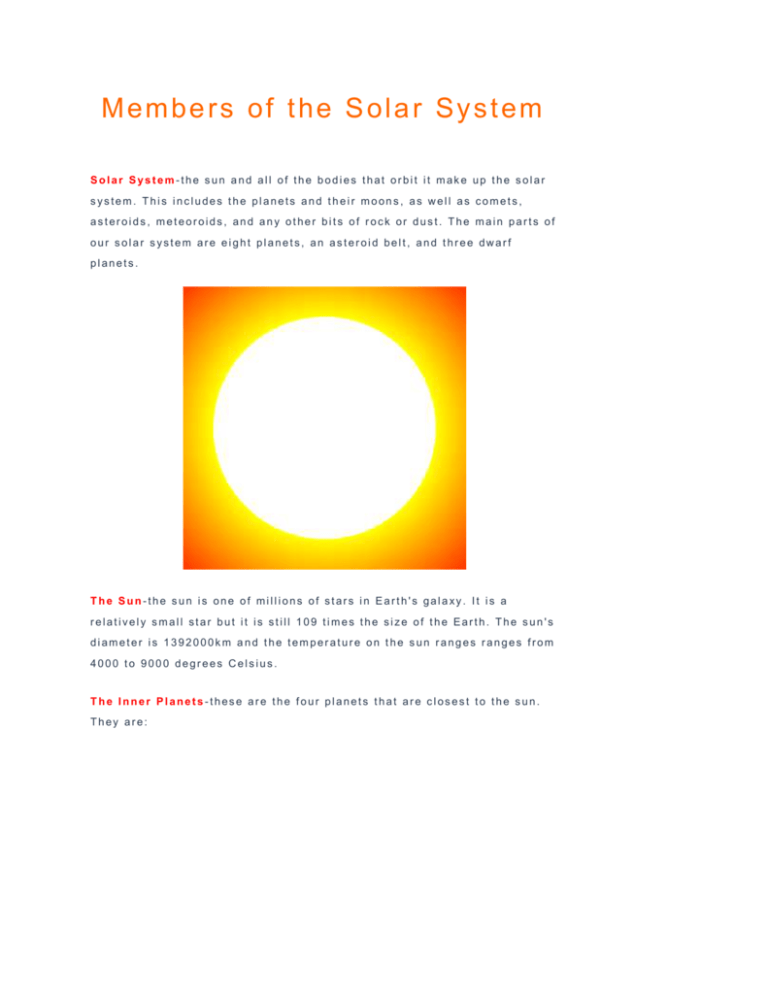
Members of the Solar System Solar System-the sun and all of the bodies that orbit it make up the solar system. This includes the planets and their moons, as well as comets, asteroids, meteoroids, and any other bits of rock or dust. The main parts of our solar system are eight planets, an asteroid belt, and three dwarf planets. The Sun-the sun is one of millions of stars in Earth's galaxy. It is a relatively small star but it is still 109 times the size of the Earth. The sun's diameter is 1392000km and the temperature on the sun ranges ranges from 4000 to 9000 degrees Celsius. The Inner Planets-these are the four planets that are closest to the sun. They are: 1. Mercury-this is the smallest of the 8 planets and closest to the sun. It is a small roc ky planet covered with craters. It has no atmosphere or moons . 2.-Venus-this is the second planet from the sun. It is a small rocky planet with no moons. This planet has a thick atmosphere of mainly carbon dioxide which also has miles of thick sulfuric acid clouds. It's the hottest planet in our solar system at 465 degrees Celsius. 3-Earth-this is the third planet from the sun. It is the only planet known to support life. One moon orbits the Earth. 4-Mars-this is the fourth planet from the sun. Mars has permanent ice caps on both of its poles. Mars is known for having dust storms and strong winds. Mars' surface is made up of iron -rich dust which gives it it's reddish appearance. Mars has two tiny moons. T he Ast er oi d Bel t - t hi s lies bet ween t he I n ner Pl anet s and Out er Pl an et s . It is made up of rocks, ice and metal. The Outer Planets-the next four planets in our solar system are referred to as the gas giants because they are mainly made up of gas and are much larger than the inner planets. The outer planets are: 1. Jupiter-this is the fifth planet from the sun and the largest of the 8 planets. It is about 1000 times the size of Earth. Jupiter has 63 known moons. 2. Saturn-this is the sixth planet fro m the sun and the second largest of the 8 planets. Saturn's rings are mainly made up of water and it has 59 moons. 3. Uranus-this is the seventh pl anet from the sun and the third largest of the 8 planets. It is made of rock and ice and has 27 moons. 4. Neptune-it is the eighth planet from the sun. Neptune's winds are the fastest in our solar system, they can reach speeds of 2000 kilometres per hour. Neptune has 13 moons. The Dwarf Planets-these are too small to be called planets but too large to be called asteroids. The three dwarf planets are: 1. Ceres-it is found in an asteroid belt in our solar system. 2. Pluto-Pluto has 3 moons and is usually farther from the sun than Neptune. The orbit of Pluto and Neptune cross as certain points making Pluto closer to the sun than Neptune. 3. Eris-it is furthest away from the sun of the dwarf planets and has one moon. It is the largest of the dwarf planets. The Moons-moons are naturally occurring satellites that orbit the planets. Only Mercury and Venus don't have moons. Io, one of Jupiter's moons, is the most volcanically active body in our solar system. Ast eroids and Meteoroids -these are too small to be called planets. Asteroids are large rocky fragments while Meteoroids are smaller fragments of rock. W hen a meteoroid hits the Earth's surface, it's called a meteorite. Manicougan crater, in Quebec, is the fifth largest crater in the world measuring 100 km across. Comets-consist mostly of gas, ice and dust. They orbit in large, oval orbits. As comets approach the sun, the ice melts creating the comet's tail.

